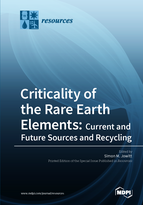Criticality of the Rare Earth Elements: Current and Future Sources and Recycling
A special issue of Resources (ISSN 2079-9276).
Deadline for manuscript submissions: closed (30 June 2017) | Viewed by 105259
Special Issue Editor
Interests: economic gology; igneous petrology; global metal and mineral resources; geochemistry; Large Igneous Provinces; mineral exploration; the environmental impact of mining; wealth from waste and the use of mine waste as a resource; mineral economics
Special Issue Information
Dear Colleagues,
Rare earth elements (REE) are critical to our modern way of life; however, potential primary and secondary sources of these elements remain somewhat poorly understood. In particular, comparatively little research has been undertaken on the potential for recycling and reuse of these elements and the extraction of these critical elements from waste material. This Special Issue focuses on furthering our understanding of the criticality and potential sources of the rare earth elements, with a specific focus on secondary sources, including waste from mining and processing activities, the potential for extraction of the REE from high technology or electronic waste, and techniques for extracting the REE from unconventional sources. We also invite submissions that cover the positive and negative impact of these potential sources, as well as papers that present research on primary REE mineral deposits, mineral deposits that are prospective for the REE but either are not currently exploited or deport their contained REE to waste, and the potential for future REE production from hitherto unexploited REE-bearing mineral deposit types. The papers published in this Special Issue will provide further insight into the full life cycle of the REE, information that is vital to ensure sustainable sources of these critical elements into the future.
Dr. Simon Jowitt
Guest Editor
Manuscript Submission Information
Manuscripts should be submitted online at www.mdpi.com by registering and logging in to this website. Once you are registered, click here to go to the submission form. Manuscripts can be submitted until the deadline. All submissions that pass pre-check are peer-reviewed. Accepted papers will be published continuously in the journal (as soon as accepted) and will be listed together on the special issue website. Research articles, review articles as well as short communications are invited. For planned papers, a title and short abstract (about 100 words) can be sent to the Editorial Office for announcement on this website.
Submitted manuscripts should not have been published previously, nor be under consideration for publication elsewhere (except conference proceedings papers). All manuscripts are thoroughly refereed through a single-blind peer-review process. A guide for authors and other relevant information for submission of manuscripts is available on the Instructions for Authors page. Resources is an international peer-reviewed open access monthly journal published by MDPI.
Please visit the Instructions for Authors page before submitting a manuscript. The Article Processing Charge (APC) for publication in this open access journal is 1600 CHF (Swiss Francs). Submitted papers should be well formatted and use good English. Authors may use MDPI's English editing service prior to publication or during author revisions.
Keywords
- rare earth elements
- critical metals
- global mineral resources
- recycling
- substitution
- life cycle assessment






